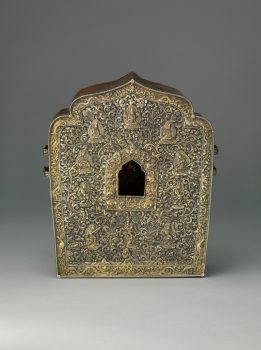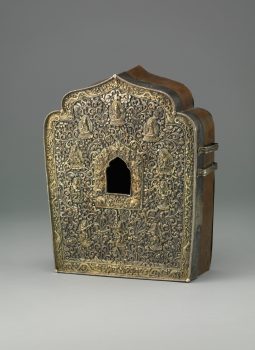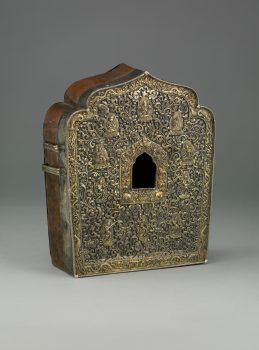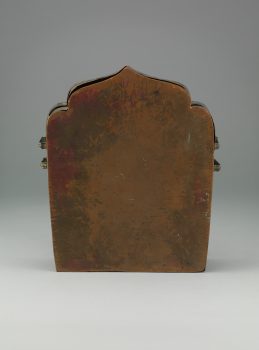Tibet
19th century




Tibet
19th century




This amulet box (gau) would have been filled with religious contents to protect the wearer as well as serve as a portable shrine. The central window of such an amulet usually reveals a particularly precious object, such as a small sculpture or relic. The window’s frame is decorated with the six auspicious symbols known as the “throne ornaments”—from bottom to top on both sides: an elephant, lion, antelope (sharabha) ridden by a god (deva), sea monster (makara), serpent deity (naga), and garuda. Above the window are three important teachers of the Geluk School of Tibetan Buddhism—the school’s founder, Tsongkhapa (1357–1419), flanked by his two chief disciples—identifying the sectarian affiliation of the owner. Flanking the top of the window’s arch are two wealth deities, Vaishravana seated on a lion on the left (see detail) and the goddess Vasudhara on the right. The five dancing goddesses below personify the offerings of the five senses (clockwise from the right): touch, smell, sight, hearing, and taste. The outer gilt border is a decorative pattern of alternating dragons and phoenixes. The amulet box’s multilayered scrollwork and delicate figurative details testify to the accomplishment of the craftsmen who made it. Selective gilding further amplifies the preciousness of the work.
A religious movement that originated in India around the fifth to seventh century with sacred writings and esoteric teachings and practices transmitted from teacher to student through initiation. These remain an important part of Hinduism and Buddhism today.
A kind of energy that can be used, individually and collectively, to effect change.
Prescribed practices that carry symbolic meaning and value within a specific tradition and are intended to attain a desired outcome. Rituals are usually done as part of a ceremony or regular routine.
Today, Tibetans primarily inhabit the Tibetan Plateau, situated between the Himalayan mountain range and the Indian subcontinent to the west, Chinese cultural regions to the east, and Mongolian cultural regions to the northeast. During the 7th to 9th century, Tibetan rulers expanded their empire across Central Asia, and established Buddhism as the state religion.
Get the latest news and stories from the Rubin, plus occasional information on how to support our work.